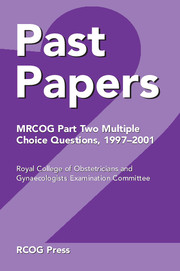September 1999
Published online by Cambridge University Press: 05 July 2014
Summary
Nuchal translucency
1. is diagnostic of a chromosomal abnormality.
The following features observed on antenatal ultrasound scanning are associated with Turner syndrome:
2. hydrops fetalis at 20 weeks of gestation.
3. structural heart anomalies.
Ultrasonic features of intrauterine growth retardation include
4. an increased incidence of fetal breathing movements.
5. maximum amniotic pool depth less than 2 cm.
6. increased pulsatility index in the umbilical arteries.
Chorionic villus sampling (CVS)
7. may diagnose a chromosome abnormality not expressed in the fetus.
8. increases the risk of limb reduction deformities.
9. is associated with a higher false positive rate than is amniocentesis.
Fetal blood sampling during the antenatal period
10. is necessary for the diagnosis of fetal beta-thalassaemia.
11. results in 10–15% incidence of premature rupture of the membranes.
12. is indicated in the investigation of fetal hydrops.
Examination of the amniotic fluid allows a specific diagnosis of
13. Hurler's syndrome.
14. fetal exomphalos.
15. retinoblastoma.
The following conditions would be expected to conform to the pattern of inheritance shown in Figure 4:
16. glucose-6-phosphate dehydrogenase deficiency.
17. Huntington's chorea.
18. osteogenesis imperfecta.
The following disorders are correctly associated with the mode of inheritance:
19. Duchenne's disease (hypertrophic muscular dystrophy) : X-linked recessive.
20. Tay-Sach's disease : autosomal recessive.
With regard to Down syndrome,
21. if the mother is a carrier of balanced translocation (type 21/13–15) the risk of a child being born with Down syndrome is 50%.
22. the incidence in babies born to women over 40 years is between 5% and 10%.
23. 95% are of the non-dysjunctional variety.
24. the paternal chromosome constitution is irrelevant.
Information
- Type
- Chapter
- Information
- Past Papers MRCOG Part Two Multiple Choice Questions1997–2001, pp. 84 - 102Publisher: Cambridge University PressPrint publication year: 2004
